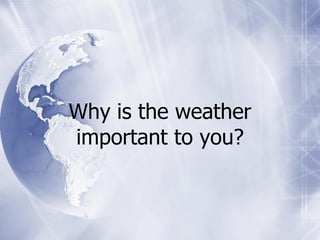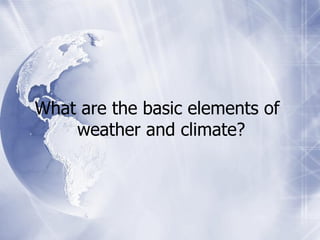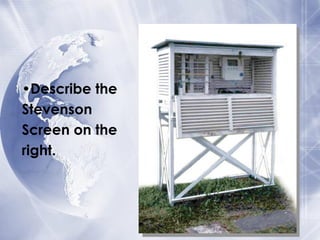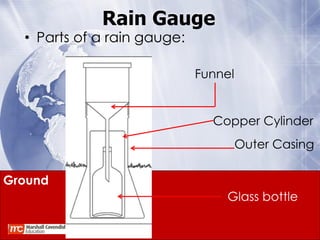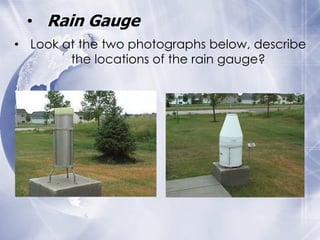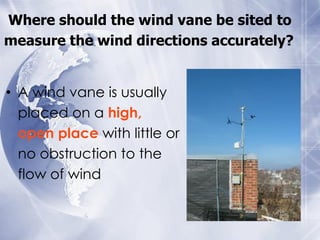Chapter 11 Weather and Climate lesson slides published
- 1. CHAPTER 11 WEATHER AND CLIMATE
- 2. Learning Outcomes You Will Learn: • to differentiate between weather and climate • about the use and siting of weather instruments • to compare weather and climatic data to understand weather and climatic variations • about the distribution and characteristics of the world’s major climatic types • how weather and climate affect people positively and negatively
- 3. Why is the weather important to you?
- 4. CLOTHES!
- 5. FOOD!
- 6. HOLIDAYS!
- 7. Why is the weather important to you? • Weather affects our daily lives. • Weather affects the ways we lead our daily activities. • Weather affects the types of houses we live in.
- 8. What is the difference between weather and climate?
- 9. Definition of Weather • Conditions in the atmosphere of a particular area at a particular point in time. • Short-term conditions. • Changes all the time and varies from place to place.
- 10. Definition of Climate • Climate refers to the weather pattern of a place over a long period of time, usually 30 years or more • Long- term conditions. • Seldom change.
- 11. What’s the climate like?
- 12. Weather Climate Short term Long Term Daily, Weekly Usually 30 years or more Changes all the time Seldom change. and varies from place to place.
- 13. What are the basic elements of weather and climate?
- 14. • The basic elements of weather and climate: Temperature Rainfall Wind
- 15. Temperature What is Temperature?
- 16. Describe the temperature in the morning, at noon and evening yesterday
- 17. Definition of Temperature • Temperature refers to the degree of hotness or coldness of the air • It varies throughout the day in a place • It varies from place to place
- 18. It varies throughout the day in a place
- 19. It varies from place to place Equator
- 20. It varies from place to place • Places nearer the Equator are warmer throughout the year than places farther away from it • The increase in distance away from the from the Equator is known as Latitude.
- 21. It varies from place to place Mount Kenya
- 22. It varies from place to place • Temperature gets cooler as we go to higher grounds • As the Altitude gets higher, the Temperature gets lower • Give me 1 location in Malaysia that is influence by Altitude.
- 23. How do we measure Temperature?
- 24. • Air temperature is measured with a thermometer • The scale is in degree Celsius (OC) • Daily maximum temperature refers to the highest temperature reading for the day • Daily minimum temperature refers to the lowest temperature reading for the day
- 25. A Minimum and Maximum Thermometer ( Six’s Thermometer) Minimum thermometer Maximum thermometer Contains alcohol mercury and a metal index Measure the minimum Temperature rises> temperature mercury expands Why is alcohol used? mercury pushes the index up Temperature falls > mercury contracts and stays in place How do you reset t he thermometer?
- 26. How do we read the temperature using a Six’s thermometer?
- 27. • What is the minimum and maximum temperature shown in the thermometer on the right? Minimum temp = 13 oC Maximum temp = 32 oC • By taking the bottom of the index.
- 28. Where are the thermometers placed to measure temperature?
- 30. •Describe the Stevenson Screen on the right.
- 31. •Stevenson Screen Parts Why 1 White in color reflects heat 2 Louvres allows air to flow freely through it 3 Raised above shelters the instruments form ground the heat radiating from the ground 4 Face north Do not get the direct heat and south from the sun
- 32. Where should a Stevenson Screen be located and why?
- 33. •Describe the locations of the Stevenson Screen on the
- 34. Where is the best location to place a Stevenson Screen in School
- 35. A: In an open field – Air will circulate easily in the Stevenson Screen as the Screen is in an open space and is far away from buildings. B: Within the school – Heat within the building may affect the instruments inside the Screen. – The Screen may be disturbed by people. Eg People may open the Screen door and this will affect the reading of the instruments.
- 36. C: Under the trees – The Screen will be in the shade, protected from direct sunlight. – Air may not circulate freely under the trees. D: On the basketball court – Instruments inside the Screen may be affected by the heat from the ground. – People in the basketball court may disturb the Screen. Ans: Choice A best fulfills the criteria set for the siting of a Stevenson Screen.
- 38. Learning Outcomes You Will Learn: • Definition of rainfall. • How it is rainfall formed • How is rainfall measured.
- 39. Rainfall
- 40. Why do we study rainfall? Too much? Too little? http://www.youtube.com/watch?v=Y1BgYeepNlE&feature=re lated
- 41. Definition of rainfall • refers to the amount of rain that an area receives over a period of time •It is measured in millimetres (mm) or centimetres (cm)
- 42. How is rain formed 3 Condensation 2 Transpiration 4 Rain or snow falls 1 Evaporation
- 43. How is rainfall measured? • A rain gauge is an instrument used to measure rainfall
- 44. Rain Gauge • Parts of a rain gauge: Funnel Copper Cylinder Outer Casing Ground Glass bottle
- 45. Calculating Rainfall • Daily rainfall refers to the amount of rain that falls over 24 hours • Monthly rainfall refers to the total amount of rainwater collected throughout the month • Annual rainfall is the total amount of rainwater collected throughout the year
- 46. Rainfall Map(Refer to textbook page 142) •Rainfall map shows the distribution of annual rainfall in a place for a period of time
- 47. •Refer to textbook page 142 CVSS isohyets •Name 1 location that has the same amount of rainfall as CVSS •Name 1 location that has less amount of rainfall than CVSS •Name 1 location that has more amount of rainfall than CVSS
- 48. • Temperature is displayed as a line graph in a climograph • Rainfall is displayed as bar in a climograph
- 49. • Rain Gauge • Look at the two photographs below, describe the locations of the rain gauge?
- 50. • Discuss in pair: (5 minutes) 1. Which is the most suitable location to place a Rain Gauge. Give Two reasons for your answer 2. Explain why the other sites are not suitable?
- 52. Learning Outcomes You Will Learn: • Definition of wind. • How it is wind formed? • How to read wind directions? • Where should a wind vane be sited? • How to read a wind rose?
- 53. Wind Why do we study wind? Too much? Too Little?
- 54. What is wind?
- 55. Definition of wind: • Wind is defined as the movement of air over the surface of the Earth.
- 56. How is wind formed? http://www.youtube.com/watch?v=itj-x1XhzQo&feature=related
- 57. • The Earth is heated up at a different rate. • Warm air expands and rises up while cool air condenses and sinks. • Low Pressure is formed when warm air rise. •Cool air will move in from area of high pressure to replace the warm air that rises. •Wind if formed when cool air blows from area of high to area of low pressure.
- 58. How is wind direction measured? • Wind direction is given by the compass point of North, South, East and West. • A wind vane is used to measure the direction of the wind.
- 59. How is wind direction measured? • The pointer on the wind vane points to the direction that the wind is blowing from. SE N
- 60. Where should the wind vane be sited to measure the wind directions accurately? • A wind vane is usually placed on a high, open place with little or no obstruction to the flow of wind
- 61. Where should the wind vane be sited to measure the wind directions accurately? B C A
- 62. Learning Outcomes You Will Learn: • To compare weather and climatic data to understand weather and climatic variations • About the distribution and characteristics of the world’s major climatic types
- 63. Major Climatic Types of the World • Temperature and rainfall are commonly used to classify different climates of the world • Three broad types of the world’s climates Tropical Temperate Polar • A climograph is used to present the climatic data of a place
- 64. Climograph: Describe the key information that you can derive from the climograph of Singapore shown below.
- 65. Climograph: 1 1. Location of the place 2 2. Latitude of the place 3. Months ( J,F,M,A……..) 4 5 4. Temperature (o C ) 5. Amount of Precipitation (mm or cm) 3
- 66. Climograph: • A line graph shows the mean monthly temperature during the year • A bar graph shows the average precipitation for each month
- 67. Climograph: • What is the average annual temperature for Singapore? • What is the total annual rainfall for Singapore? •What is the annual temperature range?
- 68. Major Climatic Types of the World- Tropical Climate • Places with a tropic climate Lie on or near the Equator In the region known as the Tropics, between the Tropic of Cancer (23.5oN) and the Tropic of Capricorn (23.5oS)
- 69. Major Climatic Types of the World- Tropical Climate • Places with a tropic climate o o Experience high temperatures ranging from 20 C to 30 C Receive almost the same amount of sunlight all year around Receive high annual rainfall ranging from 1000 to 2000 millimetres or more Has a small annual temperature range. • Characteristics of places with a tropical climate: High temperature and high rainfall throughout the year Hot and wet climate eg Singapore, Malaysia, Brazil and Kenya
- 70. Major Climatic Types of the World- Temperate Climate • Places with a temperate climate Lie between the Tropic of Cancer (23.5oN) and Arctic Circle (66.5oN), and between the Tropic of Capricorn (23.5oS) and Antarctic Circle (66.5oS)
- 71. Major Climatic Types of the World- Temperate Climate • Places with a temperate climate Experience four seasons every year: spring, summer, autumn (or fall) and winter Receive different amounts of sunlight in different periods of the year hence, temperatures vary greatly throughout the year Annual rainfall is moderate (300 to 1000 millimetres) • Characteristics of places with a temperate climate Low to Moderate temperatures depending on the season Moderate rainfall throughout the year Examples: Korea, Japan and the United States of America
- 72. Major Climatic Types of the World- Polar Climate • Places with a polar climate o o Lie between Arctic Circle (66.5 N) and the North Pole (90 N), o o and between Antarctic Circle (66.5 S) and the South Pole (90 S)
- 73. Major Climatic Types of the World- Polar Climate • Places with a polar climate Experience only summer and winter From March to September: the North Pole receives six months of continual sunshine while the South Pole faces six months of darkness Are very dry because the air lacks water vapour for the formation of clouds and rain or snow • Characteristics of places with a polar climate Very low temperatures (often below freezing point) and rainfall throughout the year eg Arctic, Antarctica, Northern Canada and Siberia
- 74. • Guide to describe the climate of a place : 1. Describe the temperature. 2. Describe the total annual rainfall. 3. Describe the annual temperature range. 4. Describe any distinct rainfall or temperature if they are present. E.g. Hot and wet, four seasons etc.
- 75. Major Climatic Types of the World- Practise time: Base on the climographs provided in the next slide: a. Describe the climate of the locations. b. Identify the type of climate associated with the locations.
- 76. Major Climatic Types of the World- Climograph 1 Climograph 2 Climograph 3
- 77. Major Climatic Types of the World- Climograph 1 1. It has low to moderate temperature depending on the season. In winter, the temperature is around -10oC and 22oC in the summer. 2. It has a low annual rainfall of less than 1000mm 3. It has a large annual temperature range of about 32 oC 4. It has 4 seasons. 5. It probably has a Temperate climate.
- 78. Major Climatic Types of the World- Climograph 2 1. It has high temperature averaging 27 degree Celsius. 2. It has a small annual temperature range of about 2 to 3 degree Celsius. 3. Its has high annual rainfall of more than 2000mm 4. This place is hot and wet. 5. It has no season. 6. It probably has a Tropical Equatorial climate.
- 79. Major Climatic Types of the World- Climograph 3 1. It has very low temperature throughout the whole year. ( -28oC to - 3oC 2. It has very low rainfall throughout the year with an annual rainfall of less 300mm 3. It has a large annual temperature range of about 25oC 4. It probably experience summer and winter only 5. It probably has a Polar climate.
- 80. Learning Outcomes You Will Learn: • how weather and climate affect humans positively and negatively.
- 81. How Weather and Climate Affect Us • Study the photographs on the next slide 1st row to look at picture A 2nd row to look at picture B 3rd row to look at picture C 4th row to look at picture D 5th row to look at picture E 6th and 7th row to look at picture F • Write down on the same piece of paper earlier: Describe any activities or things that caught your attention on the photographs Describe how they can be related to climate and weather?
- 82. How Weather and Climate Affect Us • Daily activities Weather will determine whether we stay indoors or participate in outdoor activities.
- 83. How Weather and Climate Affect Us • The Daily activities Weather will determine the types of activities we can engage in.
- 84. How Weather and Climate Affect Us • Housing The locations people choose to live in. People prefer to live in places where it is neither too hot nor too cold.
- 85. How Weather and Climate Affect Us • Housing The climate will also influence the types of housing people live in. eg In many Southeast Asian countries, houses are built on stilts to prevent water from damaging their property during floods
- 86. How Weather and Climate Affect Us • Tourism The different climates experienced around the world encourage tourism
- 87. How Weather and Climate Affect Us •Production of electricity Modern-day windmills harness the energy from the wind to generate electricity. Solar energy is harness from the sun to generate electricity. Hydroelectric power is harness from fast-moving water to generate electricity.
- 88. How Weather and Climate Affect Us •Production of electricity The wind, water and sun are known as renewable resources. Can be naturally restored or replenished Petroleum, natural gas and coal are non-renewable resources
- 89. How Weather and Climate Affect Us • Food and water supplies Different crops thrive under different climatic conditions
- 90. How Weather and Climate Affect Us • Food and water supplies Changes in the climate will affect crops and animals e.g a drought will destroy crops and reduce water supplies which can result in a famine and affect livestock
- 91. How Weather and Climate Affect Us •Loss of lives and property Extreme weather conditions can destroy many lives and property e.g. floods, heat waves and hurricanes
- 92. Spend 3 minutes to answer these questions EXIT SLIP: Describe any 3 ways that weather and climate can affect us: Something that I still do not understand is :


